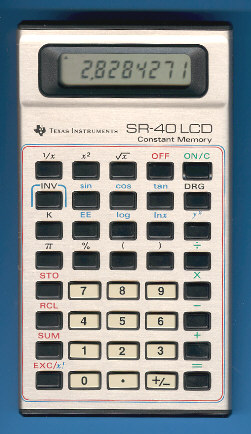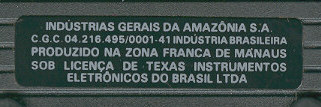
DATAMATH CALCULATOR MUSEUM
 |
DATAMATH CALCULATOR MUSEUM |
Texas Instruments SR-40 LCD
| Date of introduction: | 1980 | Display technology: | LCD |
| New price: | Display size: | 8 (5 + 2) | |
| Size: | 5.3" x 2.9" x 1.0" 135 x 74 x 26 mm3 |
||
| Weight: | 3.4 ounces, 97 grams | Serial No: | 75329 |
| Batteries: | 2*AA | Date of manufacture: | mth 08 year 1983 |
| AC-Adapter: | Origin of manufacture: | Italy | |
| Precision: | 11 | Integrated circuits: | TP0320-4/CD3202 |
| Memories: | 1 | ||
| Program steps: | Courtesy of: | Joerg Woerner |

 Fellow
collector Paulo Rogerio Romagna, Brazil donated recently this wonderful and rare
SR-40 LCD. Thanks!
Fellow
collector Paulo Rogerio Romagna, Brazil donated recently this wonderful and rare
SR-40 LCD. Thanks!
 At
first glance the SR-40 LCD manufactured in Brazil seems to be
identical with
the first version of the European TI-30 LCD. The
picture on the right demonstrates that even the different versions sporting
either the x!-key instead the
later n!-key are known.
At
first glance the SR-40 LCD manufactured in Brazil seems to be
identical with
the first version of the European TI-30 LCD. The
picture on the right demonstrates that even the different versions sporting
either the x!-key instead the
later n!-key are known.
Inserting the two AA-sized batteries into the convenient compartment on the back
of the calculator was a great surprise - instead the well known sliding cover of
the TI-30 LCD a coin is necessary to access the batteries. Comparing the two
calculators reveals lots of differences between them, only few parts are really
identical.
Please watch the next pictures carefully to get an idea of the differences:
| Instead of the plastic shell delivered with the TI-30 LCD a nice and valuable leather pouch keeps the SR-40 LCD clean and nice. |  |
| The battery compartment of the SR-40 LCD could be opened with a coin. | |
| The side-view of the SR-40 LCD is completely different to the TI-30 LCD. Please notice the strange wedge shape known from the SR-10. |
In the 1980's (and even today) Brazil maintained various
barriers to trade of both a tariff and a non-tariff barrier nature. A significant number of tariff peaks
existed and the tariff structure showed tariff escalation for all industries, with a higher tariff on finished goods than on semi-processed goods and raw materials.
The main non-tariff trade irritants included restrictive and non-transparent import licensing, imposition of minimum prices, restrictions to payment of imports, unnecessarily burdensome and costly customs procedures and protection of geographical indications.
There was lack of transparency regarding applicable rules and many elements of the trading regime appeared unnecessarily trade restrictive.
In addition, customs duties of some products remained on restrictive levels and the adverse effect of duties
was further amplified by imposition of various charges and taxes that are calculated on top of the duty paid value.
One common solution was an off-shore production of either
completely knocked-down-goods or a mixture of foreign and local material.

 Texas
Instruments licensed the SR-40 LCD to Indústrias
Gerais da Amazonia S.A. and supplied e.g. the printed circuit board (PCB),
the single-chip calculator circuit and the keyboard to them.
Texas
Instruments licensed the SR-40 LCD to Indústrias
Gerais da Amazonia S.A. and supplied e.g. the printed circuit board (PCB),
the single-chip calculator circuit and the keyboard to them.
Other components like the housing and leather pouch were
locally sourced by Indústrias Gerais da Amazonia.
Don't miss the SR-56, TI-30,
Money Manager and TI-55-II manufactured by
Texas Instrumentos Eletrônicos do Brasil Ltda. - Campinas and the
TI-1786
manufactured by SEDASA Sistemas Eletro-Eletrônicos da Amazônia S/A.
If you have additions to the above article please email: joerg@datamath.org.
© Joerg Woerner, April 30, 2004. No reprints without written permission.